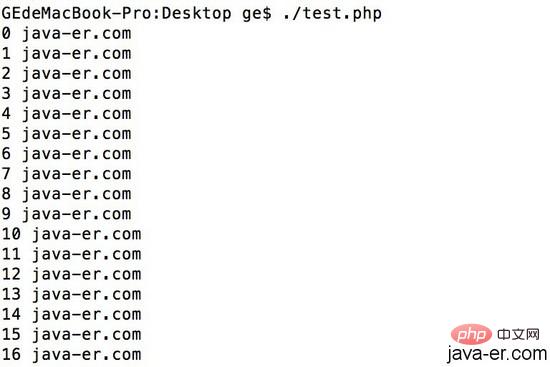
【相关学习推荐:php图文教程】
php 可以像java perl python 那样运行,今天发现如果我早早知道这个,或许我不会去学习java 和 python
当年学java不过为了一个程序放在服务器上,不停的跑啊跑,原来 php 也可以。
php -h
Usage: php [options] [-f] <file> [--] [args...]
php [options] -r <code> [--] [args...]
php [options] [-B <begin_code>] -R <code> [-E <end_code>] [--] [args...]
php [options] [-B <begin_code>] -F <file> [-E <end_code>] [--] [args...]
php [options] -S <addr>:<port> [-t docroot] [router]
php [options] -- [args...]
php [options] -a
-a Run as interactive shell
-c <path>|<file> Look for php.ini file in this directory
-n No configuration (ini) files will be used
-d foo[=bar] Define INI entry foo with value 'bar'
-e Generate extended information for debugger/profiler
-f <file> Parse and execute <file>.
-h This help
-i PHP information
-l Syntax check only (lint)
-m Show compiled in modules
-r <code> Run PHP <code> without using script tags <?..?>
-B <begin_code> Run PHP <begin_code> before processing input lines
-R <code> Run PHP <code> for every input line
-F <file> Parse and execute <file> for every input line
-E <end_code> Run PHP <end_code> after processing all input lines
-H Hide any passed arguments from external tools.
-S <addr>:<port> Run with built-in web server.
-t <docroot> Specify document root <docroot> for built-in web server.
-s Output HTML syntax highlighted source.
-v Version number
-w Output source with stripped comments and whitespace.
-z <file> Load Zend extension <file>.
args... Arguments passed to script. Use -- args when first argument
starts with - or script is read from stdin
--ini Show configuration file names
--rf <name> Show information about function <name>.
--rc <name> Show information about class <name>.
--re <name> Show information about extension <name>.
--rz <name> Show information about Zend extension <name>.
--ri <name> Show configuration for extension <name>.1.用php命令行的方式执行php脚本,例如/usr/bin/php test.php
缩写 php test.php
test.php
<?php
for($i=0;$i<10;$i++){
echo $i;
echo '\n';
}
?>2.脚本开头第一行写上#!/usr/bin/php,然后可以把脚本设为可执行 chmod a+x test.php,之后就可以用命令行的方式直接执行脚本了,例如./test.php
#!/usr/bin/php
<?php
for($i=0;$i<10;$i++){
echo $i;
echo " java-er.com \n";
}
?>执行一小时,看看php会不会挂,我希望一个命令行可以跑到天荒地老
#!/usr/bin/php
<?php
for($i=0;$i<360;$i++){
echo $i;
sleep(10);
echo " java-er.com \n";
}
?>
3. 外部传入参数
#!/usr/bin/php
<?php
var_dump($argc); //返回参数总个数
var_dump($argv);
exit;
?>
./test.php
int(1)
array(1) {
[0]=>
string(10) "./test.php"
}
./test.php a java php
int(4)
array(4) {
[0]=>
string(10) "./test.php"
[1]=>
string(1) "a"
[2]=>
string(4) "java"
[3]=>
string(3) "php"
}相关学习推荐:php编程(视频)
以上是详解php命令行写shell实例的详细内容。更多信息请关注PHP中文网其他相关文章!


